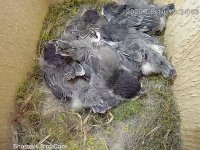Robert Dunn
Member
Last year a sparrow got into my Chickadee/Nuthatch box and destroyed the eggs. The hole measures exactly 1-1/8". The local bird store said that sometimes a sparrow can just squeak in. Now, as I sit by my window I see a pair of sparrows at it again. The Chickadee chicks are just a day or two from fledgling, so I don't want to see them killed.
I'm considering making the hole a few millimetres smaller. Today's photo attached.
What do you think?
Bob
Calgary, AB
Canada
I'm considering making the hole a few millimetres smaller. Today's photo attached.
What do you think?
Bob
Calgary, AB
Canada






